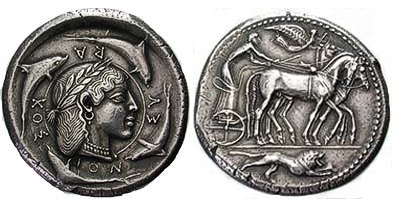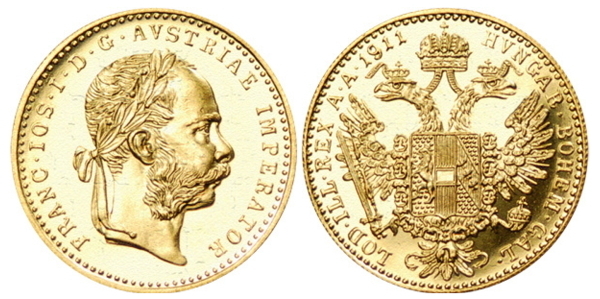Mises on Gresham’s Law and Ancient Greek Silver Coins
In an Appendix to his The Theory of Money and Credit (1912) the Austrian economist Ludwig von Mises (1881-1973) discussed the value of a silver coin issued by Gelon the King of Syracuse in 480 BC. A picture of the coin was used on the original cover of the book. Mises was interested in these coins because he believed that sound currency emerged in the ancient world as a result of the productive economic activity which went on in places such as Lydia (Turkey) and Athens. These places remained economically powerful only so long as they retained a sound currency, which he believed Athens did and the other Greek city states did not. The Appendix about this coin is included below along with the illustration.

Mises made another reference to Greek coins in Epistemological Problems of Economics (1933, 2013) in a discussion of Gresham’s Law which states that when a government issued coin is debased and thus devalued individuals will prefer to keep in hand the higher value coins and pass on in exchange the lower value debased coins. Rulers face an irresistible pressure to devalue their currency because of the demands of the treasury for more funds, the reluctance of taxpayers to pay more in taxes, and the fact that debasement of the currency is an easy, indirect, and often not immediately discernable way for the treasury to get more funds. Mises notes in passing that “Gresham’s Law” was recognized by the ancient Greeks such as the playwright Aristophanes in his play The Frogs (written about 405 BC). We quote the relevant passage here.
We also refer our readers to another “Images of Liberty and Power” illustrated essay on gold coins “The Gold Standard vs. Fiat Paper Money” including an image of an Austrian 1 Ducat Gold Coin (1911) which was contemporaneous with the appearance of Mises’ book.

Sources:
Ludwig von Mises, The Theory of Money and Credit, Indianapolis, Liberty Fund, 1981..
Ludwig von Mises, Epistemological Problems of Economics, Indianapolis, Liberty Fund, 2013..
The Comedies of Aristophanes. Literally translated with notes and extracts from metrical versions, by William James Hickie, M.A. *Vol. II. Lysistrata, The Thesmophoriazusae, Frogs, The Ecclesiazusae, and Plutus (London: George Bell and Sons, 1901).
See also:
- Images of Liberty: The Gold Standard vs. Fiat Paper Money
The Silver Demereteia of Syracuse (480-479 bc)
The silver Demereteia, which is used in the jacket design, was struck by Gelon, Lord of Syracuse, celebrating his victory over the Carthaginians in the decisive battle of Himera in Sicily. On one side of the coin is a charioteer, symbolizing Gelon’s forces, with the winged goddess of Victory, Nike, crowning the chariot with laurel. The lion in flight below represents the defeated Carthaginians. On the other side is a head, possibly that of the goddess Arethusa, since the dolphins surrounding her stand for the sea around the island of Ortygia on which the goddess was worshipped. Or, the head could be that of Gelon’s queen, Demerete, whose name was given to the coin (Demereteia) and all others of the same issue (Demereteion) in honor of her gift of personal jewelry to the treasury of Syracuse in the war with Carthage. Another legend has it that Demerete gained favorable terms for the vanquished Carthaginians and received from them a hundred talents of gold which she contributed to financing the striking of the Demereteia.
The Greeks had learned the art of coinage from the Lydians who had invented it around 700 bc The Lydian Empire comprised most of what is now Turkey. The first Lydian coinage was developed by private individuals—goldsmiths, bankers, merchants—not by authority of the Emperor. The need for coinage as a reliable medium of exchange derived from Lydia’s position as the industrial power of the ancient world. Prior to the development of coinage, media of exchange were clumsy bars or pieces of metal.
The Greek city states adopted coinage but habitually and shamelessly debased their coins. Said Demosthenes: “the majority of states are quite open in using silver coins diluted with copper and lead.” Only Athens, excepting its one major devaluation by Solon, maintained throughout its history the purity of its coinage, a fact which does much to explain the extension of Athenian commercial and political power over all of Greece.
Gresham’s Law in Aristophanes’ The Frogs (405 BC)
Chorus
But if I am correct in discerning the life or the manners of a man, who will yet suffer for it, Cligenes the little, this ape, who now troubles us, the vilest bath-man of all, as many as are masters of soap made from adulterated soda mixed up with ashes, and of Cimolian earth, will not abide for a long time. But though he sees this, he is not for peace, lest he should one day be stripped when drunk, when walking without his cudgel.
The freedom of the city has often appeared to us to be similarly circumstanced with regard to the good and honourable citizens, as to the old coin and the new gold. For neither do we employ these at all, which are not adulterated, but the most excellent, as it appears, of all coins, and alone correctly struck, and proved by ringing every where, both among the Greeks and the barbarians, but this vile copper coin, struck but yesterday and lately with the vilest stamp; and we insult those of the citizens whom we know to be well-born, and discreet, and just, and good, and honourable men, and who have been trained in palæstras, and choruses, and music; while we use for every purpose the brazen, foreigners, and slaves, rascals, and sprung from rascals, who are the latest come; whom the city before this would not heedlessly and readily have used even as scape-goats. Yet even now, ye senseless, change your ways and again employ the good. For if you succeed, it will be creditable to you; and if you fail at all, at any rate you will seem to the wise to suffer, if you do suffer aught, from a stick which is worthy.